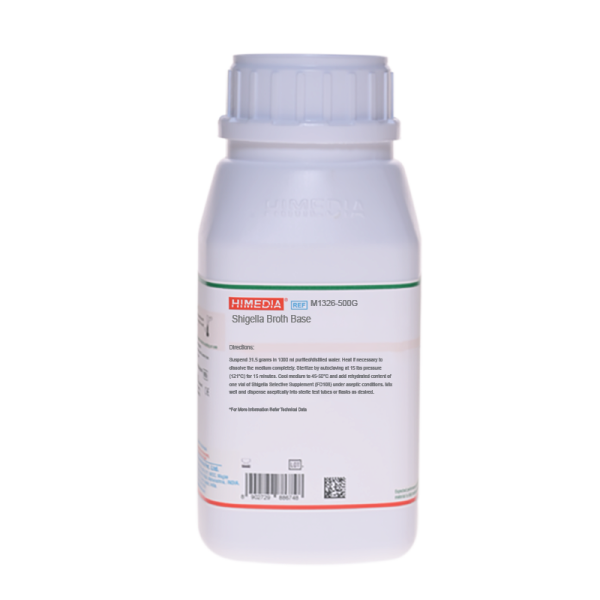 Your enquiry has been submitted
Your enquiry has been submitted
Shigella Broth Base
Intended Use
Recommended for the isolation and cultivation of Shigella species from food.
Composition
| Ingredients | Gms / Litre |
|---|---|
| Tryptone | 20.000 |
| Sodium chloride | 5.000 |
| Dipotassium hydrogen phosphate | 2.000 |
| Potassium dihydrogen phosphate | 2.000 |
| Dextrose (Glucose) | 1.000 |
| Polysorbate 80 (Tween 80) | 1.500 |
| Final pH (at 25°C) | 7.0±0.2 |
**Formula adjusted, standardized to suit performance parameters
Directions
Suspend 31.5 grams in 1000 ml purified/distilled water. Heat if necessary to dissolve the medium completely. Sterilize by autoclaving at 15 lbs pressure (121°C) for 15 minutes. Cool medium to 45-50°C and add rehydrated content of one vial of NO 0.55 Selective Supplement (FD108) under aseptic conditions. Mix well and dispense aseptically into sterile test tubes or flasks as desired.
Principle And Interpretation
Shigella are gram-negative, non-motile, non-spore forming rod-shaped bacteria closely related to Escherichia coli and Salmonella. Shigella infection is typically via ingestion (faecal-oral contamination), depending on age and condition of the host, as few as 10 bacterial cells can be enough to cause an infection. Shigella causes dysentery that results in the destruction of the epithelial cells of the intestinal mucosa in the cecum and rectum. Some strains produce enterotoxin and Shiga toxin, similar to the verotoxin of E. coli O157:H7(1). Shigella Broth Base is used for the isolation and cultivation of Shigella species (2), as recommended by APHA (3).
Shigella Broth Base contains tryptone as a source of carbon, nitrogen, vitamins and minerals. Dextrose provides the necessary carbohydrates. Buffering action in the medium is provided by dipotassium hydrogen phosphate and potassium dihydrogen phosphate. Sodium chloride maintains the osmotic balance of the medium. Polysorbate 80 is inhibitory for growth of accompanying microflora besides providing growth factors. Novobiocin is inhibitory for gram-positive bacteria such as S. aureus and certain gram-negative organisms such as H. influenzae and some species of Proteus.
Type of specimen
Food samples
Specimen Collection and Handling
For food samples, follow appropriate techniques for sample collection and processing as per guidelines (3). After use, contaminated materials must be sterilized by autoclaving before discarding.
Warning and Precautions
Read the label before opening the container. Wear protective gloves/protective clothing/eye protection/face protection. Follow good microbiological lab practices while handling specimens and culture. Standard precautions as per established guidelines should be followed while handling specimens. Safety guidelines may be referred in individual safety data sheets.
Limitations
- Further biochemical and serological tests must be carried out for further identification.
Performance and Evaluation
Performance of the medium is expected when used as per the direction on the label within the expiry period when stored at recommended temperature.
Quality Control
Appearance: Cream to yellow homogeneous free flowing powder
Colour and Clarity of prepared medium: Light amber coloured clear solution
Reaction: Reaction of 3.15% aqueous solution at 25°C. pH: 7.0±0.2
pH: 6.80-7.20
Cultural Response
Cultural characteristics observed after an incubation at 35-37°C for 18-24 hours with added NO 0.55 Selective Supplement (FD108).
| Organism | Inoculum (CFU) | Growth |
|---|---|---|
| Shigella dysenteriae ATCC 13313 | 50-100 | luxuriant |
| Shigella flexneri ATCC 12022 (00126*) | 50-100 | luxuriant |
| Shigella sonnei ATCC 25931 | 50-100 | luxuriant |
| Staphylococcus aureus subsp. aureus ATCC 25923 (00034*) | >=104 | inhibited |
Key: *Corresponding WDCM numbers.
Storage and Shelf Life
Store between 10-30°C in a tightly closed container and the prepared medium at 2 - 8°C. Use before expiry date on the label. On opening, product should be properly stored dry, after tightly capping the bottle in order to prevent lump formation due to the hygroscopic nature of the product. Improper storage of the product may lead to lump formation. Store in dry ventilated area protected from extremes of temperature and sources of ignition Seal the container tightly after use. Product performance is best if used within stated expiry period.
Disposal
User must ensure safe disposal by autoclaving and/or incineration of used or unusable preparations of this product. Follow established laboratory procedures in disposing of infectious materials and material that comes into contact with sample must be decontaminated and disposed of in accordance with current laboratory techniques (4,5).
Reference
- Hale T. L., Keusch G. T., 1996, Shigella. In: Barons Medical Microbiology (Barron S et al, Eds.), 4th Ed., Univ of Texas Medical Branch.
- Atlas R.M., 1997, Handbook of Microbiological Media 2nd Edition, CRC Press, Boca Raton, New York, London, Tokyo.
- Salfinger Y., and Tortorello M.L. Fifth (Ed.), 2015, Compendium of Methods for the Microbiological Examination of Foods, 5th Ed., American Public Health Association, Washington, D.C.
- Isenberg, H.D. Clinical Microbiology Procedures Handbook 2nd Edition.
- Jorgensen, J.H., Pfaller, M.A., Carroll, K.C., Funke, G., Landry, M.L., Richter, S.S and Warnock., D.W. (2015) Manual of Clinical Microbiology, 11th Edition. Vol. 1.
| Product Name | Shigella Broth Base |
|---|---|
| SKU | M1326 |
| Product Type | Regular |
| Physical Form | Powder |
| Origin | Animal |
| Packaging type | HDPE |
| References | 1. Hale T. L., Keusch G. T., 1996, Shigella. In: Barons Medical Microbiology (Barron S et al, Eds.), 4th Ed., Univ of TexasMedical Branch. |
| Customized Product Available | No |








